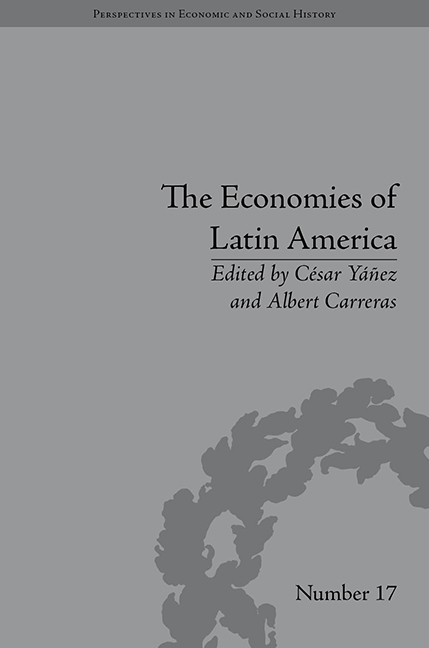Book contents
- Frontmatter
- CONTENTS
- List of Figures and Tables
- List of Contributors
- Preface
- Introduction: Latin American Economic Backwardness Revisited
- 1 Expectations, Institutions and Economic Performance: Latin America and the Western European Periphery during the Twentieth Century
- 2 On the Accuracy of Latin American Trade Statistics: A Non-Parametric Test for 1925
- 3 Latin America and Its Main Trade Partners, 1860–1930: Did the First World War Affect Geographical Patterns?
- 4 The Structure of Latin American Investment in Equipment Goods during the Mature Period of the First Globalization
- 5 Factorial Distribution of Income in Latin America, 1950–2000: New Series from the National Account Data
- 6 The Influence of the First World War on the Economies of Central America, 1900–29: An Analysis From a Foreign Trade Perspective
- 7 Economic Modernization in Adverse Institutional Environments: The Cases of Cuba and Chile
- 8 Capital Goods Imports, Machinery Investment and Economic Development in the Long Run: The Case of Chile
- 9 The Sugar Industry, the Forests and the Cuban Energy Transition, from the Eighteenth Century to the Mid-Twentieth Century
- 10 Empirical Debate on Terms Of Trade and the Double Factorial Terms of Trade of Colombia, 1975–2006
- 11 Public Revenues in Bolivia, 1900–31
- 12 The Consumption of Durable Goods in Latin America, 1890–1913: Analysis and Estimation of a Demand Function
- Notes
- Index
4 - The Structure of Latin American Investment in Equipment Goods during the Mature Period of the First Globalization
- Frontmatter
- CONTENTS
- List of Figures and Tables
- List of Contributors
- Preface
- Introduction: Latin American Economic Backwardness Revisited
- 1 Expectations, Institutions and Economic Performance: Latin America and the Western European Periphery during the Twentieth Century
- 2 On the Accuracy of Latin American Trade Statistics: A Non-Parametric Test for 1925
- 3 Latin America and Its Main Trade Partners, 1860–1930: Did the First World War Affect Geographical Patterns?
- 4 The Structure of Latin American Investment in Equipment Goods during the Mature Period of the First Globalization
- 5 Factorial Distribution of Income in Latin America, 1950–2000: New Series from the National Account Data
- 6 The Influence of the First World War on the Economies of Central America, 1900–29: An Analysis From a Foreign Trade Perspective
- 7 Economic Modernization in Adverse Institutional Environments: The Cases of Cuba and Chile
- 8 Capital Goods Imports, Machinery Investment and Economic Development in the Long Run: The Case of Chile
- 9 The Sugar Industry, the Forests and the Cuban Energy Transition, from the Eighteenth Century to the Mid-Twentieth Century
- 10 Empirical Debate on Terms Of Trade and the Double Factorial Terms of Trade of Colombia, 1975–2006
- 11 Public Revenues in Bolivia, 1900–31
- 12 The Consumption of Durable Goods in Latin America, 1890–1913: Analysis and Estimation of a Demand Function
- Notes
- Index
Summary
Introduction
Specialist literature on the Latin American economies during the mature period of the first globalization (1890–1929) has to date not studied the characteristics of the process of capital formation in these countries. This study presents a global while also detailed quantification of their investment in equipment goods, which helps to better understand the growth dynamic of these economies during this historical period, which was of vital importance in the race for economic development.
The first contribution of this study is the homogeneous annual series for spending on different types of equipment goods for a wide and representative sample of Latin American countries. This essay does not shirk the discussion of methodological problems of calculation which severely limit the overall results obtained from the sources. If reservations about methodology invite caution when dealing with the data, the results obtained advocate a revision of historiography. The most important contribution of this quantitative elaboration is that the results support the traditional view on the characterization of the productive systems of the Latin American nations as primary export economies. This, then, refutes the revisionist thesis which proposes that some nations made significant industrial progress during this period. The investment structure did not undergo any relevant change. Investment efforts focused on goods typical of the agro export model: agricultural machinery and means of transport. The only element that apparently altered the investment model arose from the process of electrification.
- Type
- Chapter
- Information
- The Economies of Latin AmericaNew Cliometric Data, pp. 69 - 82Publisher: Pickering & ChattoFirst published in: 2014



